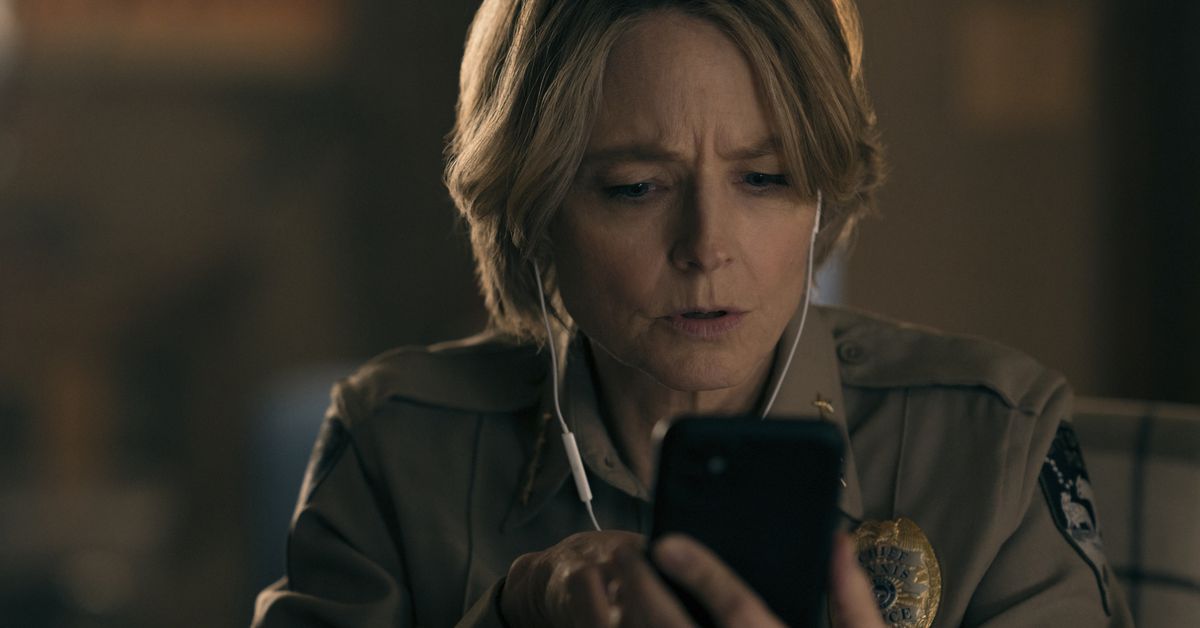True Detective: Night Country’s premiere last week signaled a return to form for the series, introducing a chilling (pun intended) mystery in form of the disappearance of a group of arctic researchers and a compelling pair of protagonists in the form of Chief Liz Danvers (Jodie Foster) and trooper Evangeline Navarro (Kali Reis). Their case is miles away — both linearly and literally — from the one True Detective dealt with in season 1. And yet, the show keeps echoing key details of that season, complete with all those supernatural elements, and of course, that goddamned creepy-looking spiral. What does it all mean? Follow me into my Rust Cohle-shaped hole as I obsessively connect the dots.
[Ed. note: spoilers for True Detective: Night Country episode 2.]
The first and most prominent reference to the previous seasons of True Detective is the crooked spiral, a symbol tattooed on the forehead of one of the Tsalal victims found frozen in the ice by Chief Danvers and her team. The symbol is a direct reference to the events of the first season, tied to a Louisiana-based sex cult being investigated by Martin Hart (Woody Harrelson) and Rustin “Rust” Cohle (Matthew McConaughey), and features prominently in several key shots from the official trailer for Night Country.
:no_upscale()/cdn.vox-cdn.com/uploads/chorus_asset/file/25235006/true_detective_night_country.jpg)
Photo: Michele K. Short/HBO
Episode 2 places its connection specifically with that of murder victim Anne Masu Kowtok, who had the symbol tattooed on her, as did her boyfriend Raymond Clark, the only member of the Tsalal research crew believed to be alive (and the current primary suspect behind the killings). And, of course, we definitely see the symbol again when Danvers and Navarro investigate Clark’s trailer, where it’s scrawled in black and red marker on the ceiling above an effigy dressed in what appear to be Anne’s clothes.
As revealed in True Detective’s first season, the crooked spiral is a symbol strongly associated with teachings of the Louisiana sex cult, who worship Hastur, or “The Yellow King,” an entity speculated to bestow boons in exchange for sacrifices in the form of young children. So far there hasn’t been much of any of that in Night Country, but who knows what’s out there on the ice.
The second reference comes later on in the episode, with Danvers asking Peter “Petey” Prior, one of her subordinates and the son of Ennis Police Captain Hank Prior, what he was able to come up with in terms of tracking down who funds the Tsalal Arctic Research Station. Petey tells Danvers that the station is funded through an NGO, which in turn is funded through a series of shell companies connected to an organization known as Tuttle United.
:no_upscale()/cdn.vox-cdn.com/uploads/chorus_asset/file/25235005/kali_reis.jpg)
Photo: Michele K. Short/HBO
Fans of True Detective should recognize that name immediately: It’s a reference to Billy Lee Tuttle, the Louisiana reverend and entrepreneur whose family was revealed to be the ringleaders of the aforementioned sex cult that Hart and Cohle were investigating in season 1. The cult is believed to be largely defunct by 2012, with the sole remaining member thought to be Errol Childress, who was killed by Rust in the finale of season 1. Then again, it’s possible the murderer is somehow associated with the Tuttle cult and for some reason is carrying on some form of their twisted rituals and teachings.
As members of the True Detective subreddit have pointed out, even the name of the research station itself may be an implicit nod to the connections between this season and season’s past. As laid out in a post by u/Magehunter_Skassi, the word “Tsalal” is Hebrew and roughly translates to “to be, to become, or to grow dark.”
:no_upscale()/cdn.vox-cdn.com/uploads/chorus_asset/file/25235013/kali_reis_0.jpg)
Photo: Michele K. Short/HBO
It’s an apt name here, given that the events of the show take place in a region of Alaska that is experiencing an extended period of darkness colloquially referred to by locals as “the Long Night.” But the word has also appeared throughout multiple examples of popular horror fiction — most prominently in “The Tsalal,” a short story by Thomas Ligotti. Ligotti is a cult figure among horror authors, known for his distinctive style of philosophical horror which series creator Nic Pizzolatto has cited as a key influence in developing the worldview of Rust Cohle.
So what does all this add up to? I don’t know — a decades-long conspiracy, a fun nod, a flat circle. True Detective could be pulling direct comparisons as clues, or they could be doing it as Easter eggs. It’s worth mentioning that production designer Daniel Taylor confirmed to Polygon that the police station has season 1 connections as set dressing. It’s also worth mentioning the exact circumstances of how Danvers and co. were first tipped off to the location of the bodies — namely, the ghost of a lady’s dead husband pointed the way. Ready for an even bigger mind-fuck? The name of that ghost is Travis Cohle, who happens to be the deceased father of, you guessed it, season one protagonist Rust Cohle.
Could it be that Danvers and Navarro are contending with a threat that is beyond criminal, but in fact supernatural? That answer feels just as likely as the former, and if either are even partially true, it means that Night Country has the potential to become one of the most exciting and terrifying mysteries of the series yet. And hell, even if it’s not, I’m still locked in at this point and along for the ride.

